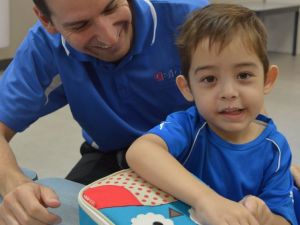
Within the paediatric population, feeding difficulties are common – in fact, it’s estimated that up to 45% of typically developing children will experience some kind of mealtime problem during childhood.
That said, children diagnosed with an autism spectrum disorder (ASD) are at a higher risk than others for developing feeding problems, and often eat a significantly narrower range of foods than children without ASD.
Feeding issues are a huge subject area: it’s because eating is a complex repertoire of behaviour. It’s an issue many families whose children attend AEIOU Foundation experience, and our program specialises in addressing this on an individual basis.
Feeding problems encompass a variety of behaviours that include food refusal and selectivity, inadequate food intake, self-feeding skill deficits, disruptive mealtime behaviours, inappropriate rate of consumption. Rumination and vomiting are also commonly reported problems.
There are many steps where something can go wrong, cementing fussy or selective eating, with problem behaviours to boot. There are a range of other potential barriers to successful eating that may require additional feeding assessments (such as medical or oral motor assessments and specialised programming), by trained professionals that may need addressed prior to working on the exposing of food items alone.
However, here we’ll discuss what you can do to support your child and for you to consider other key factors that can impact successful eating or not, such as the eating environment - does the child eat at the table? Can the child self-feed? And what is the structure at home? Is there specific rules or guidelines for family mealtimes? Or, more specifically, what is the texture of the food (this must be handled with care, with therapy input).
Throughout my career, I’ve met a number of children diagnosed with autism who have had quite unusual and restrictive or selective eating habits. To name just a few, it can range from eating only yellow starchy foods, pureed or soft foods, or chicken nuggets from McDonalds®.
Food selectivity is a behaviour that has been characterised by consumption of insufficient variety of foods as well as the rejection of most novel foods when they are presented. Food selectivity can include selectivity to type, such as starchy food, texture (only eating crunchy or pureed items), presentation (only eating sandwiches sliced diagonally), or by brand (e.g., only eating one brand of pasta and refusing all other brands).
Food selectivity has been conceptualised as a form of non-compliance in which the child refuses to eat a sufficient variety of food from the primary food categories of fruits, vegetables, proteins, and starches. When a child eats a limited variety of foods for prolonged periods, it can result in serious health problems, ranging from malnutrition to severe growth and development delays.
Some paediatricians and other professions typically recommend a “wait and see” approach to the treatment of feeding problems with the idea that the child will “outgrow” the problem. However, when persistent food selectivity presents a more serious health risk, intervention will be required.
Feeding problems often involve physical or biological factors although environmental factors participate and contribute considerably to problematic eating. To say the least abnormal eating habits usually do not arise solely because of organic impairment but persistent feeding problems are maintained as a result of environmental factors. Therefore you need to consider is your child actively influencing your (the server’s) behaviour?
As parents, consider whether you have withdrawn a food item or stopped presenting a food item(s) to avoid inappropriate refusal-type behaviours? Alternatively, have problem behaviours given the child access to more time and/or feedback with you as the presenter of the food item, such as coaxing or reprimands for not eating?
If you answer yes, this can become particularly problematic for a child with selective eating. This subsequently shapes the caregiver behaviour, whereby you only present foods that you’re confident the child will consistently consume and then avoid exposing new foods to avoid tantrumming or other problem behaviours.
I have also found that when kids are selective eaters, there is a tendency for the caregiver to present unusual portion sizes of the preferred foods i.e. 10 chicken nuggets of dinner. This is a red flag area – do not do this! I strongly advise you (the caregiver) to consider who is teaching who in the caregiver-to-child relationship. This must not be forgotten in any eating intervention.
The most common treatment for milder selectivity is food exposure programs. Simply put, this includes presenting preferred foods along with non-preferred food items. It’s important to continue presenting foods your child doesn’t like, and if problem behaviour occurs on the presentation of non-preferred food items speak with your therapy team. Our team is skilled in this area, and can provide you with tools and advice to implement at home.
The obstacles faced by parents and caregivers with a child who has feeding difficulties are varied and accessing services to treat more persistent longer-standing feeding difficulties prove challenging. The key is to catch the problem early, and always remember milder forms of food selectivity can be treated by the least intrusive intervention methods, such as repeated exposure to food items. Reinforcement can be provided for trying new foods, but be mindful the end goal is for the food to be reinforcing itself with consumption by taste.
Please note: as eating is a complex area I strongly recommend that you consult with your program managers and therapy teams at AEIOU before you take on such a sensitive area. If you’re not yet enrolled at AEIOU Foundation, but you’re on our waitlist, keep an eye out for a workshop at a centre near you. We regularly host free workshops which waitlisted families are welcome to attend.
About the author: Claire McIvor is AEIOU Foundation's Program Coordinator (Senior Behaviour Therapist). She is passionate about promoting the need to introduce new foods into a children’s diets and/or environment as early as possible. Claire holds a Masters in Applied Behaviour Analysis and has been an integral member in the AEIOU team since 2013.

Tags: Mealtimes, Children With Autism, Food, Eating Problems


































